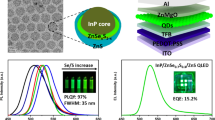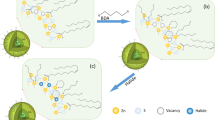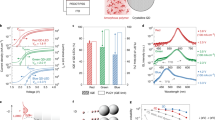Abstract
Quantum dot (QD) light-emitting diodes (LEDs) are ideal for large-panel displays because of their excellent efficiency, colour purity, reliability and cost-effective fabrication1,2,3,4. Intensive efforts have produced red-, green- and blue-emitting QD-LEDs with efficiencies of 20.5 per cent4, 21.0 per cent5 and 19.8 per cent6, respectively, but it is still desirable to improve the operating stability of the devices and to replace their toxic cadmium composition with a more environmentally benign alternative. The performance of indium phosphide (InP)-based materials and devices has remained far behind those of their Cd-containing counterparts. Here we present a synthetic method of preparing a uniform InP core and a highly symmetrical core/shell QD with a quantum yield of approximately 100 per cent. In particular, we add hydrofluoric acid to etch out the oxidative InP core surface during the growth of the initial ZnSe shell and then we enable high-temperature ZnSe growth at 340 degrees Celsius. The engineered shell thickness suppresses energy transfer and Auger recombination in order to maintain high luminescence efficiency, and the initial surface ligand is replaced with a shorter one for better charge injection. The optimized InP/ZnSe/ZnS QD-LEDs showed a theoretical maximum external quantum efficiency of 21.4 per cent, a maximum brightness of 100,000 candelas per square metre and an extremely long lifetime of a million hours at 100 candelas per square metre, representing a performance comparable to that of state-of-the-art Cd-containing QD-LEDs. These as-prepared InP-based QD-LEDs could soon be usable in commercial displays.
This is a preview of subscription content, access via your institution
Access options
Access Nature and 54 other Nature Portfolio journals
Get Nature+, our best-value online-access subscription
$29.99 / 30 days
cancel any time
Subscribe to this journal
Receive 51 print issues and online access
$199.00 per year
only $3.90 per issue
Buy this article
- Purchase on Springer Link
- Instant access to full article PDF
Prices may be subject to local taxes which are calculated during checkout




Similar content being viewed by others
Data availability
The data that support the findings of this study are available from the corresponding author upon reasonable request.
References
Coe, S., Woo, W.-K., Bawendi, M. & Bulovic, V. Electroluminescence from single monolayers of nanocrystals in molecular organic devices. Nature 420, 800–803 (2002).
Qian, L., Zheng, Y., Xue, J. & Holloway, P. Stable and efficient quantum-dot light-emitting diodes based on solution-processed multilayer structures. Nat. Photon. 5, 543–548 (2011).
Mashford, B. S. et al. High-efficiency quantum-dot light-emitting devices with enhanced charge injection. Nat. Photon. 7, 407–412 (2013).
Dai, X. et al. Solution-processed, high-performance light-emitting diodes based on quantum dots. Nature 515, 96–99 (2014).
Manders, J. R. et al. High efficiency and ultra-wide color gamut quantum dot LEDs for next generation displays. J. Soc. Inf. Disp. 23, 523–528 (2015).
Wang, L. et al. Blue quantum dot light-emitting diodes with high electroluminescent efficiency. ACS Appl. Mater. Interf. 9, 38755–38760 (2017).
Bae, W. K. et al. Controlling the influence of Auger recombination on the performance of quantum-dot light-emitting diodes. Nat. Commun. 4, 2661 (2013).
Yang, Y. et al. High-efficiency light-emitting devices based on quantum dots with tailored nanostructures. Nat. Photon. 9, 259–266 (2015).
Cao, W. et al. Highly stable QLEDs with improved hole injection via quantum dot structure tailoring. Nat. Commun. 9, 2608 (2018).
Li, Y. et al. Stoichiometry-controlled InP-based quantum dots: synthesis, photoluminescence, and electroluminescence. J. Am. Chem. Soc. 141, 6448–6452 (2019).
Reiss, P., Carriere, M., Lincheneau, C., Vaure, L. & Tamang, S. Synthesis of semiconductor nanocrystals, focusing on nontoxic and earth-abundant materials. Chem. Rev. 116, 10731–10819 (2016).
Tessier, M. D., Dupong, D., Nolf, K. D., Roo, J. D. & Hens, Z. Economic and size-tunable synthesis of InP/ZnE (E=S, Se) colloidal quantum dots. Chem. Mater. 27, 4893–4898 (2015).
Stein, J. L. et al. Probing surface defects of InP quantum dots using phophorus Kα and Kβ X-ray emission spectroscopy. Chem. Mater. 30, 6377–6388 (2018).
Tessier, M. D. et al. Interfacial oxidation and photoluminescence of InP-based core/shell quantum dots. Chem. Mater. 30, 6877–6883 (2018).
Mićić, O. I., Jones, K. M., Cahill, A. & Nozik, A. J. Optical, electronic, and structural properties of uncoupled and close-packed arrays of InP quantum dots. J. Phys. Chem. B 102, 9791–9796 (1998).
Mićić, O. I., Smith, B. B. & Nozik, A. J. Core-shell quantum dots of lattice-matched ZnCdSe2 shells on InP cores: experiment and theory. J. Phys. Chem. B 104, 12149–12156 (2000).
Liu, L. et al. Shape control of CdSe nanocrystals with zinc blende structure. J. Am. Chem. Soc. 131, 16423–16429 (2009).
Lim, J. et al. Influence of shell thickness on the performance of light-emitting devices based on CdSe/Zn1-xCdxS core/shell heterostructured quantum dots. Adv. Mater. 26, 8034–8040 (2014).
Bae, W. K. et al. Controlled alloying of the core-shell interface in CdSe/CdS quantum dots for suppression of Auger recombination. ACS Nano 7, 3411–3419 (2013).
Lakovicz, J. R. Principles of Fluorescence Spectroscopy (Springer, 2006).
Kagan, C. R., Murray, C. B. & Bawendi, M. G. Long-range resonance transfer of electronic excitations in close-packed CdSe quantum-dot solids. Phys. Rev. B 54, 8633 (1996).
Klimov, V. I., Mikhailovsky, A. A., McBranch, D. W., Leatherdale, C. A. & Bawendi, M. G. Quantization of multiparticle Auger rates in semiconductor quantum dots. Science 287, 1011 (2000).
Vaxenburg, R., Rodina, A., Lifshitz, E. & Efros, A. L. Biexciton Auger recombination in CdSe/CdS core/shell semiconductor nanocrystals. Nano Lett. 16, 2503–2511 (2016).
Park, Y.-S. et al. Near-unity quantum yields of biexciton emission from CdSe/CdS nanocrystals measured using single-particle spectroscopy. Phys. Rev. Lett. 106, 187401 (2011).
Cao, F. et al. A layer-by-layer growth strategy for large-size InP/ZnSe/ZnS core-shell quantum dots enabling high-efficiency light-emitting diodes. Chem. Mater. 30, 8002–8007 (2018).
Jo, J.-H. et al. High-efficiency red electroluminescent device based on multishelled InP quantum dots. Opt. Lett. 41, 3984–3987 (2016).
Wang, H. C. et al. Cadmium-free InP/ZnSeS/ZnS heterostructure-based quantum dot light-emitting diodes with a ZnMgO electron transport layer and a brightness of over 10000 cd m-2. Small 13, 1603962 (2017).
Lim, J. et al. Highly efficient cadmium-free quantum dot light-emitting diodes enabled by the direct formation of excitons within InP@ZnSeS quantum dots. ACS Nano 7, 9019–9026 (2013).
Shen, H. et al. Visible quantum dot light-emitting diodes with simultaneous high brightness and efficiency. Nat. Photon. 13, 192–197 (2019).
Kim, Y. et al. Bright and uniform green light emitting InP/ZnSe/ZnS quantum dots for wide color gamut displays. ACS Appl. Nano Mater. 2, 1496–1504 (2019).
Park, Y., Lim, J., Makarov, N. & Klimov, V. I. Effect of interfacial alloying versus “volume scaling” on Auger recombination in compositionally graded semiconductor quantum dots. Nano Lett. 17, 5607–5613 (2017).
Acknowledgements
We thank B. G. Chae, H. Park and H. Heo for their assistance with TEM, GC-MS and ICP-AES.
Author information
Authors and Affiliations
Contributions
The synthesis of the QDs and structural analysis were performed by Y.-H.W. and H.J. The QD-LEDs were fabricated and characterized by O.C. and D.-Y.J. The HR-STEM images were obtained by J.L. The photophysical properties of the QDs were studied by T.K., T.K., H.C. and D.K. This research was designed and coordinated by E.J. This manuscript was written by Y.-H.W. and E.J. in consultation with all authors.
Corresponding author
Ethics declarations
Competing interests
The authors declare no competing interests.
Additional information
Publisher’s note Springer Nature remains neutral with regard to jurisdictional claims in published maps and institutional affiliations.
Peer review information Nature thanks Peter Reiss and the other, anonymous, reviewer(s) for their contribution to the peer review of this work.
Extended data figures and tables
Extended Data Fig. 1 Characteristics of the InP core QD.
a, Ultraviolet–visible absorption spectrum of InP core 2 and a valley depth (VD) defined as VD = 1 − (Absmin/Absmax). b, Plot of VD of InP core versus FWHM of InP/ZnSe/ZnS QDs prepared with each respective InP core. R2 is the proportion of the variance from the regression model. c, X-ray photoelectron spectroscopy profiles of P2p of InP core 2 before and after the HF treatment (inset, schematic structure of the InP surface before and after HF addition). d, High-resolution-STEM image. e, Histogram of the diameters of core 2.
Extended Data Fig. 2 Crystalline structures of the QDs.
a, X-ray diffraction patterns of the core 2, QD-1, QD-1R, QD-2, QD-2R, QD-3 and QD-3R. b, High-resolution-STEM image and corresponding fast Fourier transform pattern on the [\(11\bar{1}\)] zone axis (B) of QD-3R. The atomic distance d of the crystalline facet of (\(02\bar{2}\)) was 0.1984 nm.
Extended Data Fig. 3 Electronic structures of the InP/ZnSe/ZnS QDs and their performances in the devices.
a, Valence band maximum measurement with photoelectron microscopy of QD-1, 2, 3, 1R, 2R and 3R. b, Current density–voltage profiles of the hole-only devices and electron-only devices using QD-1, 2, 3, 1R, 2R and 3R. c, Energy level diagram of the reference LED device. d, Electroluminescence spectra of the QD-LEDs using QD-1, 2, 3, 1R, 2R and 3R, depending on the operation voltages.
Extended Data Fig. 4 Photophysical characteristics based on the time-resolved spectroscopy and electron–hole distributions.
a–c, Static photoluminescence spectra of the QD solution (S) and the QD film (F, solid line) together with the dynamic photoluminescence spectra (dashed lines) of the QD film collected at each decay time (0–20 ns) of: a, QD-1R; b, QD-2R; and c, QD-3. d–i, Spectrally integrated photoluminescence decay profiles of the QD in solution and film of: d, QD-1; e, QD-2; f, QD-3; g, QD-1R; h, QD-2R; and i, QD-3R. The number next to the label of each photoluminescence decay profile indicates the average photoluminescence lifetime. From the average photoluminescence lifetimes, the energy transfer efficiency was calculated as Ef = 1 − τfilm/τsol and is given next to the sample name. j–l, The electron and hole distributions were calculated with an effective mass approximation of: j, QD-1, 1R; k, QD-2, 2R; and l, QD-3, 3R. (RC is the effective core radius, defined as a radius of the sphere that confines each electron or hole carrier with 90% probability based on the effective mass approximation calculation.) m–o, Transient absorption dynamics of m, QD-1, n, QD-2, and o, QD-3R.
Extended Data Fig. 5 Ligand characterization before and after the exchange reaction.
a, b, GC-MS data (a) and TGA data (b) of QD-3R and QD-3R-HA before and after the ligand exchange with quantitative analytical data. c, 1H NMR spectra of HA and Zn(HA)2 in toluene-d8. Zn(HA)2 is dissolved in TOA and the asterisk indicates TOA solvent peaks.
Extended Data Fig. 6 Performance of the QD-LEDs.
a, b, Histograms of maximum EQEs (a) and turn-on voltages at 0.1 cd m−2 (b) measured from 47 QD-LEDs with QD-3R-HA. c, Current density–voltage profiles of electron- and hole-only devices fabricated with QD-3R and QD-3R-HA. d, Voltage versus operation time for the QD-LEDs with QD-3R and QD-3R-HA operated at a constant current fixed initially at about1,000 cd m−2.
Extended Data Fig. 7 Lifetime measurements and acceleration factor.
a, Lifetimes of the QD-LED with QD-3R-HA at 985 cd m−2, 2,903 cd m−2 and 10,050 cd m−2. b, Acceleration factor calculated for different conditions by fitting T95 and T90 data.
Rights and permissions
About this article
Cite this article
Won, YH., Cho, O., Kim, T. et al. Highly efficient and stable InP/ZnSe/ZnS quantum dot light-emitting diodes. Nature 575, 634–638 (2019). https://doi.org/10.1038/s41586-019-1771-5
Received:
Accepted:
Published:
Issue Date:
DOI: https://doi.org/10.1038/s41586-019-1771-5
This article is cited by
-
Dipole–dipole-interaction-assisted self-assembly of quantum dots for highly efficient light-emitting diodes
Nature Photonics (2024)
-
Helical-caging enables single-emitted large asymmetric full-color circularly polarized luminescence
Nature Communications (2024)
-
Insights into structural defect formation in individual InP/ZnSe/ZnS quantum dots under UV oxidation
Nature Communications (2024)
-
Stable and efficient pure blue quantum-dot LEDs enabled by inserting an anti-oxidation layer
Nature Communications (2024)
-
Switchable interfacial reaction enables bright and stable deep-red perovskite light-emitting diodes
Nature Photonics (2024)
Comments
By submitting a comment you agree to abide by our Terms and Community Guidelines. If you find something abusive or that does not comply with our terms or guidelines please flag it as inappropriate.



